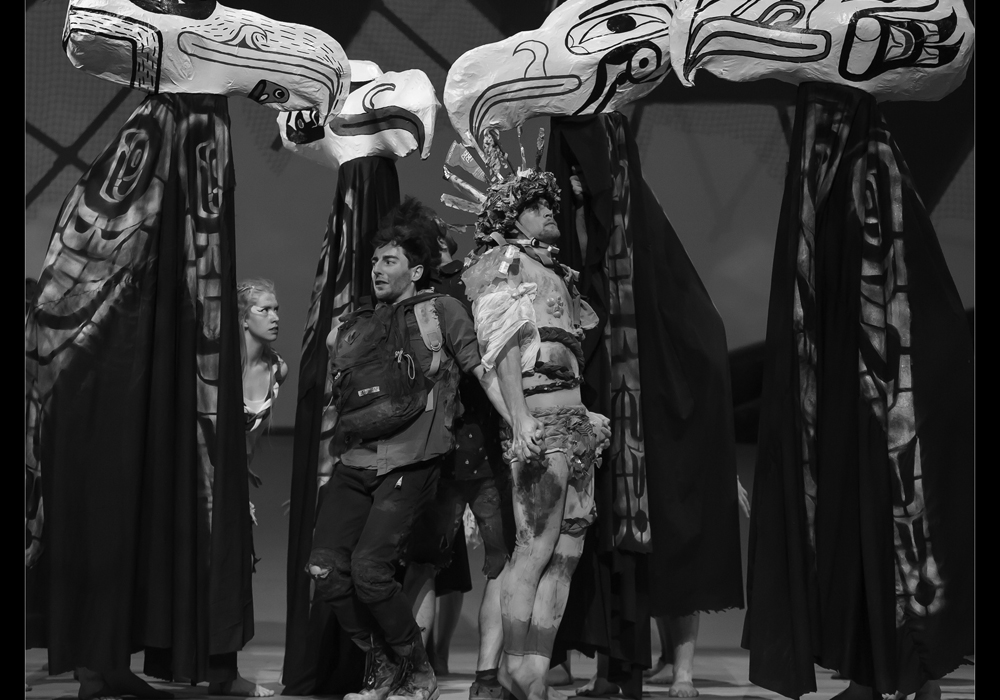Bernice Afriyie, Staff Writer
Featured image courtesy of Jeremy Mimnagh
The interdisciplinary performance The Birds, presented by the School of the Arts, Media, Performance and Design and Theatre@York, ran from March 20 to 26. The Birds is Yvette Nolan’s modern reworking of the play by ancient Grecian playwright Aristophanes, combined with the ancient Roman poet Ovid’s tale of Philomela and Procne. Nolan infuses her First Nations heritage into the production as she shifts the setting to Turtle Island, North America, and reimagines the two humans Jack and Gulliver as weary city dwellers in search of refuge in a bird paradise.
The play opened with words from artistic director Michael Greyeyes on the importance of honouring sacred First Nations lands and the need for cultural unity, followed by a greeting and smudging prayer in Lakota by artist Philip Cote.
Through the use of digital projections, interpretive dance, and oral tales, The Birds emphasizes the importance of storytelling. Stunning 3D projections and images assist in the retelling of the creation story and the birth and life of Raven. The 3D images collapses the fourth wall, reaching into the audience and calling us too, to participate in the shaping of the world. The synchronized, elegant movements of the dancers throughout the production, coupled with the original score and meticulous costume design and makeup beautifully captured the movements of real birds.
In act one, the choreography mirrored the persistence and strength of the female mind and body, particularly the strong female bond that Philomela and Procne shared. At the end of the act, as some birds collapse and others struggle to revive them, the three tricksters call out female names, suggesting women in literature and real life who have been victims of brutality and violence.
Framed by the three female tricksters, the scene speaks to the nameless First Nations women of Canada, victims of sexual assault and abuse who have no voices of their own and are shunned by the media and legal system. Philomela’s transformation and loss of speech after Tereus rapes her hints at the white colonial attack on First Nations women, culture, ways of life, and languages. When Philomela transforms into a swallow, her severed tongue and use of body language as speech mirrors the racist denial of First Nations people in residential schools, their language, and customs.
However, the swallow’s silence is not a branding, but a refusal to participate in the language of her abusers. Unlike the owls, ducks, shrikes, hawks, and other birds who are required to order and rank themselves and speak in English as opposed to their individual forms of bird-talk, the swallow does not speak the English of colonizers. Her simple actions show that it’s possible for women to exist outside of the contexts of their abuse and for First Nations cultures to find new ways of expressing themselves without compromising their identities.
In act two, Gulliver’s desire to colonize the land of the birds and build walls is a clever allusion to the European colonization of First Nations land, followed by the Canadian sanctioning of reserves: first, as settlers forcefully occupied sacred land and second as the Canadian government put First Nations people onto reserves. Gulliver and Jack’s arrival sets off a similar outcome to Canada’s stories of violent conquest.
Thematically, The Birds succeeds in conveying First Nations themes and concerns, yet the noticeably predominantly white cast should make us wonder if occupying First Nations bodies is not itself a form of cultural appropriation. As the directors were limited to the students from York’s theatre department and the casting choices weren’t staged to be self-satirizing, the issue goes beyond the walls of the play. In one of Canada’s most diverse and populated schools, which boasts the largest and most comprehensive theatre program, putting on a play about the dangers of cultural and racial colonization, why are there token representations of race?
Like us on Facebook, @excalweb


